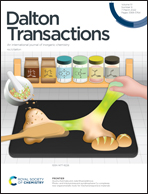Reactions of N-heterocyclic carbene-based chalcogenoureas with halogens: a diverse range of outcomes†
Abstract
We have investigated the reactions of chalcogenoureas derived from N-heterocyclic carbenes, referred to here as [E(NHC)], with halogens. Depending on the structure of the chalcogenourea and the identity of the halogen, a diverse range of reactivity was observed and a corresponding range of structures was obtained. Cyclic voltammetry was carried out to characterise the oxidation and reduction potentials of these [E(NHC)] species; selenoureas were found to be easier to oxidise than the corresponding thioureas. In some cases, a correlation was found between the oxidation potential of these compounds and the electronic properties of the corresponding NHC. The reactivity of these chalcogenoureas with different halogenating reagents (Br2, SO2Cl2, I2) was then investigated, and products were characterised using NMR spectroscopy and single-crystal X-ray diffraction. X-ray analyses elucidated the solid-state coordination types of the obtained products, showing that a variety of possible adducts can be obtained. In some cases, we were able to extrapolate a structure/activity correlation to explain the observed trends in reactivity and oxidation potentials.



 Please wait while we load your content...
Please wait while we load your content...